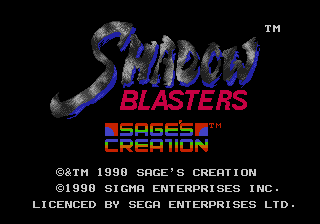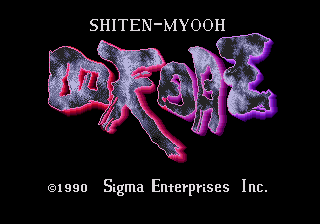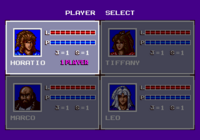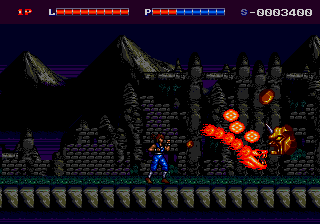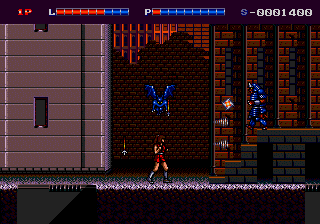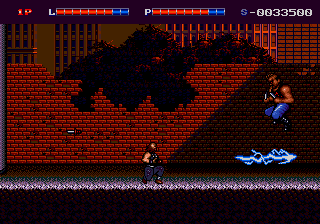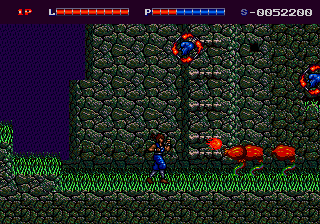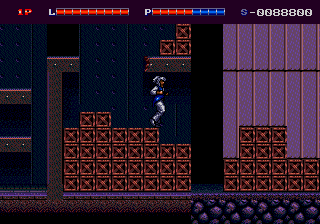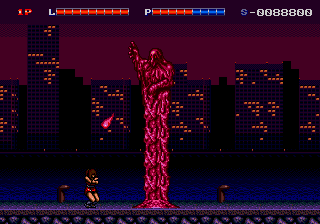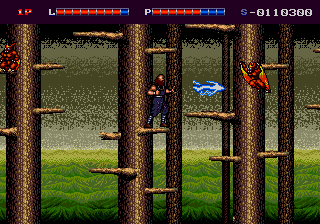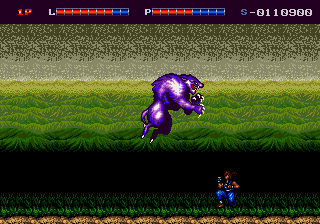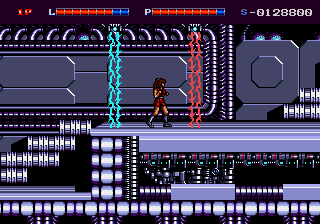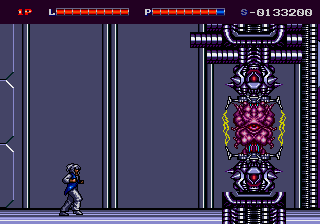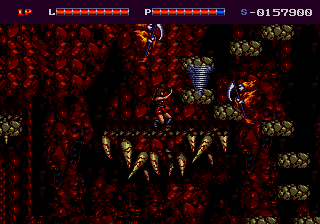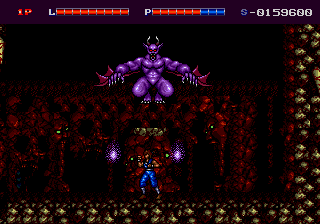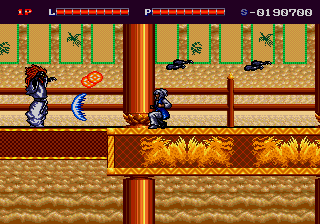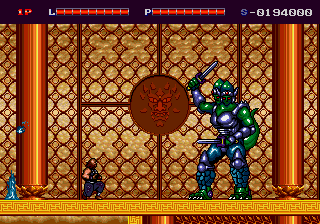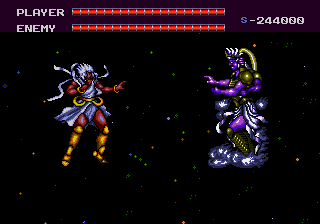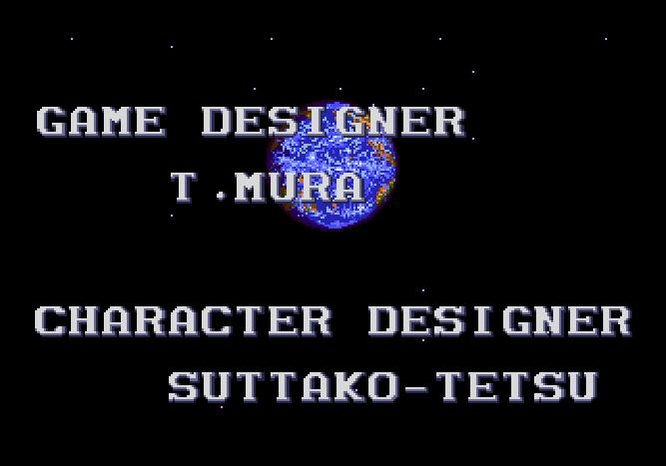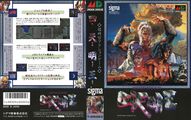Shadow Blasters
From Sega Retro
| |||||||||||||||
| Shadow Blasters | |||||||||||||||
|---|---|---|---|---|---|---|---|---|---|---|---|---|---|---|---|
| System(s): Sega Mega Drive | |||||||||||||||
| Publisher: Sigma Enterprises (Japan), Sage's Creation (US) | |||||||||||||||
| Developer: Sigma Pro-Tech[1] | |||||||||||||||
| Supporting companies: Cyclone System (subcontracting) | |||||||||||||||
| Genre: Action[2] | |||||||||||||||
| Number of players: 1-2 | |||||||||||||||
|
Shadow Blasters, known in Japan as Shiten Myouou (四天明王 lit. 4 Dawning Kings), is a Sega Mega Drive action platform game developed by Sigma Pro-Tech. First published in Japan by Sigma Enterprises in August 1990, it was later localized and brought to the United States by Sage's Creation later that year.
Contents
Story
The evil god Ashura has unleashed hordes of monsters and demons onto Earth, hoping to take control of the planet as well as the hearts of men. The good god Hyperion has recruited four of Earth's most powerful warriors and assembled them into a team to fight the encroaching darkness and defeat Ashura: the ninja warriors named Kotarou and Ayame, a Buddhist fighting monk named Kidenbou, and a fencer named Senshirou. In the game's English localization, their names were changed to Horatio, Tiffany, Marco, and Leo, respectively.
Gameplay
Shadow Blasters is a side-scrolling platform game. There are four characters. Each character is able to walk with ![]() and
and ![]() , jump with
, jump with ![]() , kneel with
, kneel with ![]() , and jump off platforms with
, and jump off platforms with ![]() +
+![]() . The player can fire a projectile weapon unique to the selected character with
. The player can fire a projectile weapon unique to the selected character with ![]() . For the most part, the player is free to move forward and backward through a given level as desired. As the player progresses, characters become more powerful by picking up power-ups for the attributes of speed, jump, and power. Power-ups are specific to each character. If a character is already at the maximum level for an attribute, collecting its power-up has no effect.
. For the most part, the player is free to move forward and backward through a given level as desired. As the player progresses, characters become more powerful by picking up power-ups for the attributes of speed, jump, and power. Power-ups are specific to each character. If a character is already at the maximum level for an attribute, collecting its power-up has no effect.
At the beginning of each stage, the player can choose from a pool of four characters. The player can switch characters at any point during game play by pressing START and choosing a different character from the selection screen. This screen also shows each character's attribute levels. Each character has a life bar with nine segments. Life bar segments are lost when the character takes damage from an enemy, but there are items that restore the life bar. Once a character dies, he or she cannot be revived. The game is over when all four characters have died. The player can continue as many times as desired but loses all character upgrades in doing so.
Each character's weapon has nine levels, represented by segments on their power bar, with four distinct stages, reached at every third level. Holding ![]() charges the weapon to a higher level for a single shot. Projectiles can be fired while jumping or kneeling or fired directly up with
charges the weapon to a higher level for a single shot. Projectiles can be fired while jumping or kneeling or fired directly up with ![]() +
+![]() . There is also a special attack that destroys all enemies on the screen with
. There is also a special attack that destroys all enemies on the screen with ![]() . Each character can use this attack once per stage.
. Each character can use this attack once per stage.
There is also a cooperative 2-player mode where two players fight through the stages together.
Characters
| Horatio (小太郎) | |
|---|---|
| A ninja with the power of fire. His base attack throws shurikens straight ahead. At level 3, he throws small fireballs. At level 6, he throws larger fireballs. At level 9, he unleashes a fire dragon. | |
| Tiffany (アヤメ) | |
| A ninja with the power of wind. Her base attack throws bombs, which arc in front of her and land on the ground. At level 3, she shoots wind blasts at an upward angle. At level 6, she shoots two wind blasts at upward and downward angles, forming a conical shape. At level 9, she hurls a tornado. | |
| Marco (気電坊) | |
| A Buddhist monk with the power of lightning. His base attack shoots energy balls that bow upward. At level 3, he shoots short energy bolts straight ahead. At level 6, he shoots long lightning bolts. At level 9, he shoots three stacked lightning bolts. | |
| Leo (千四郎) | |
| A master fencer. His base attack throws knives directly in front of him. At level 3, he shoots boomerangs that return to him, damaging enemies coming and going. At level 6, he shoots two boomerangs at once. At level 9, he shoots a single large boomerang that shoots again after returning once. |
Items
| Red Emblem | |
|---|---|
| Increases the selected character's speed, up to a maximum of 4. The current level is indicated by the "S" value on the character select screen. | |
| Blue Emblem | |
| Increases the selected character's jumping ability, up to a maximum of 4. The current level is indicated by the "J" value on the character select screen. | |
| White Emblem | |
| Increases the selected character's power, up to a maximum of 9. The current level is indicated by the number of red segments on the character's power bar when not charged. | |
| Crimson Emblem | |
| Heals the selected character for one hit point. | |
| Explosive Emblem | |
| Heals the selected character's complete life bar. |
Stages
The first six stages can be played in any order. The remaining three stages are played in sequence after the first six have been completed.
| Mountain | |
|---|---|
| Street | |
| Glen | |
| Harbor | |
| Forest | |
| Future | |
| Wicked World | |
| Heavenly Sky | |
| Space | |
| The last stage is played as Hyperion against Ashura. |
Versions
Localised names
| Language | Localised Name | English Translation |
|---|---|---|
| English (US) | Shadow Blasters | Shadow Blasters |
| Japanese | 四天明王 | Shiten Myouou |
Production credits
- Game Designer: T.Mura
- Character Designer: Suttako‑Tetsu
- Scroll Designer: Goro Tama, TS‑25
- Programmer: X Y Z, Hiroshi Sato
- Sound Programmer: M.Takayama
- Sound Composer: Songdong Kim
- Thanks...: Zerozero X, Garam, Katsu, Angela, Mr. Ogulin
Magazine articles
- Main article: Shadow Blasters/Magazine articles.
Promotional material
Physical scans
| ExpandSega Retro Average |
|---|
| 50 | |
|---|---|
| Based on 14 reviews | |
Technical information
- Main article: Shadow Blasters/Technical information.
References
- ↑ http://gdri.smspower.org/wiki/index.php/Interview:Shouichi_Yoshikawa
- ↑ Jump up to: 2.0 2.1 https://sega.jp/history/hard/megadrive/software_l.html (Wayback Machine: 2020-07-02 23:21)
- ↑ Beep! MegaDrive, "June 1990" (JP; 1990-05-08), page 6
- ↑ https://groups.google.com/g/rec.games.video/c/cEccyoEu3ZU/m/VfsA-OX7ByIJ
- ↑ https://groups.google.com/g/rec.games.video/c/oyVa4engkUU/m/ynoE3b69TpgJ
- ↑ Jump up to: 6.0 6.1 VideoGames & Computer Entertainment, "November 1990" (US; 1990-1x-xx), page 62
- ↑ File:Shadow Blasters MD credits.pdf
- ↑ Game Players Sega Guide!, "Vol. 1, No. 1: Fall 1990" (US; 1990-10-xx), page 15
- ↑ 1700 igr dlya Sega, "" (RU; 2001-xx-xx), page 202
- ↑ Aktueller Software Markt, "Mai 1991" (DE; 1991-04-26), page 124
- ↑ Beep! MegaDrive, "September 1990" (JP; 1990-08-08), page 24
- ↑ Famitsu, "" (JP; 1990-xx-xx), page 1
- ↑ Joystick, "Octobre 1990" (FR; 1990-xx-xx), page 107
- ↑ Sega Mega Drive Advanced Gaming, "January 1993" (UK; 199x-xx-xx), page 94
- ↑ Mega Drive Fan, "November 1990" (JP; 1990-10-08), page 63
- ↑ Mega Play, "February 1991" (US; 199x-xx-xx), page 43
- ↑ Power Play, "11/90" (DE; 1990-10-12), page 142
- ↑ Sega Power, "October 1991" (UK; 1991-09-05), page 54
- ↑ Sega Pro, "April 1993" (UK; 1993-03-11), page 67
- ↑ Sega Saturn Magazine, "September 1995" (JP; 1995-08-08), page 87
- ↑ Tricks 16 bit, "Tricks Sega Gold 800 igr" (RU; 1998-03-20), page 153
| CollapseShadow Blasters | |
|---|---|
|
Main page | Comparisons | Maps | Hidden content | Magazine articles | Reception | Region coding | Technical information | Bootlegs | |
